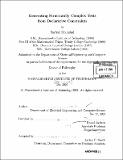| dc.contributor.advisor | Daniel Jackson. | en_US |
| dc.contributor.author | Khurshid, Sarfraz, 1972- | en_US |
| dc.contributor.other | Massachusetts Institute of Technology. Dept. of Electrical Engineering and Computer Science. | en_US |
| dc.date.accessioned | 2006-03-24T18:17:54Z | |
| dc.date.available | 2006-03-24T18:17:54Z | |
| dc.date.copyright | 2003 | en_US |
| dc.date.issued | 2004 | en_US |
| dc.identifier.uri | http://hdl.handle.net/1721.1/30083 | |
| dc.description | Thesis (Ph. D.)--Massachusetts Institute of Technology, Dept. of Electrical Engineering and Computer Science, February 2004. | en_US |
| dc.description | Includes bibliographical references (leaves 119-126). | en_US |
| dc.description.abstract | This dissertation describes a method for systematic constraint-based test generation for programs that take as inputs structurally complex data, presents an automated SAT-based framework for testing such programs, and provides evidence on the feasibility of using this approach to generate high quality test suites and find bugs in non-trivial programs. The framework tests a program systematically on all nonisomorphic inputs (within a given bound on the input size). Test inputs are automatically generated from a given input constraint that characterizes allowed program inputs. In unit testing of object-oriented programs, for example, an input constraint corresponds to the representation invariant; the test inputs are then objects on which to invoke a method under test. Input constraints may additionally describe test purposes and test selection criteria. Constraints are expressed in a simple (first-order) relational logic and solved by translating them into propositional formulas that are handed to an off-the-shelf SAT solver. Solutions found by the SAT solver are lifted back to the relational domain and reified as tests. The TestEra tool implements this framework for testing Java programs. Ex-periments on generating several complex structures indicate the feasibility of using off-the-shelf SAT solvers for systematic generation of nonisomorphic structures. The tool also uncovered previously unknown errors in several applications including an intentional naming scheme for dynamic networks and a fault-tree analysis system developed for NASA. | en_US |
| dc.description.statementofresponsibility | by Sarfraz Khurshid. | en_US |
| dc.format.extent | 126 leaves | en_US |
| dc.format.extent | 5368098 bytes | |
| dc.format.extent | 5367906 bytes | |
| dc.format.mimetype | application/pdf | |
| dc.format.mimetype | application/pdf | |
| dc.language.iso | eng | en_US |
| dc.publisher | Massachusetts Institute of Technology | en_US |
| dc.rights | M.I.T. theses are protected by copyright. They may be viewed from this source for any purpose, but reproduction or distribution in any format is prohibited without written permission. See provided URL for inquiries about permission. | en_US |
| dc.rights.uri | http://dspace.mit.edu/handle/1721.1/7582 | |
| dc.subject | Electrical Engineering and Computer Science. | en_US |
| dc.title | Generating structurally complex tests from declarative constraints | en_US |
| dc.title.alternative | Constraint-based generation of structurally complex tests | en_US |
| dc.type | Thesis | en_US |
| dc.description.degree | Ph.D. | en_US |
| dc.contributor.department | Massachusetts Institute of Technology. Department of Electrical Engineering and Computer Science | |
| dc.identifier.oclc | 55667181 | en_US |
